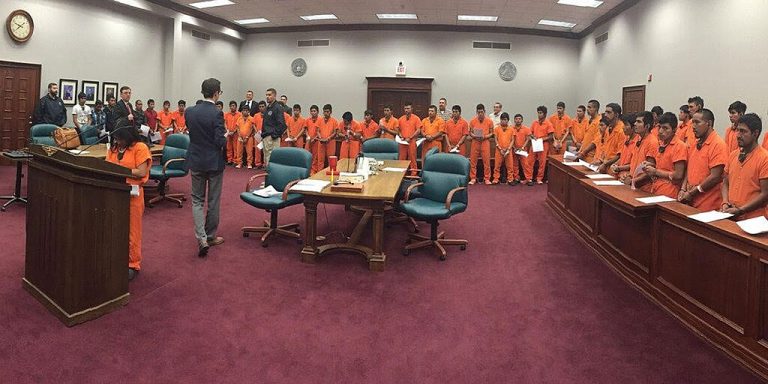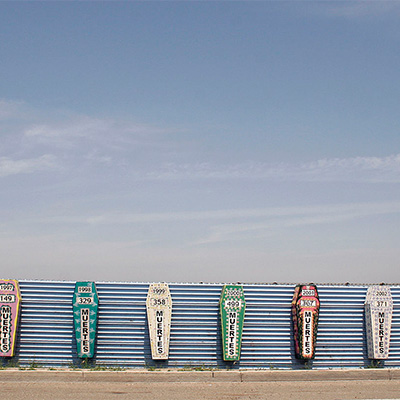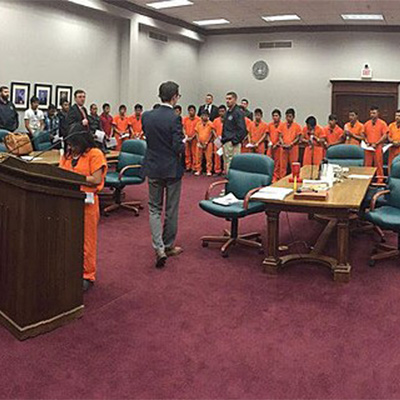1991-Now
Deportation Nation
Who gets to enter the United States?

Since 1991, more than 31 million immigrants have received lawful permanent resident status in the United States. This number does not reflect the millions of people who have come to the United States outside legal channels and remain without status. Currently, there are an estimated 12 million undocumented people living in the U.S. today, most of whom have lived here for more than a decade. Nor do these numbers reflect the migrants prevented from arriving in the United States by the expansion of border controls beyond the physical boundaries of the United States. Although the 1951 Refugee Convention, its 1967 Protocol, and the Refugee Act of 1980 entitle people to apply for asylum if they reach the United States, the Supreme Court reads those laws not to extend protection to people stopped abroad, even if by the U.S. government. Since 1924, when Congress first required immigrants to acquire entry visas from consular authorities abroad, U.S. authorities have pressured foreign governments to impose travel controls that stop immigrants from arriving at U.S. borders and ports of entry without prior authorization from the United States government. Beginning in the 1990s, the U.S. started to directly finance and support efforts in Mexico to dissuade Mexican and Central American migrants from making the journey north, and to stop those who tried before they could reach the border. More recently, authorities have leveraged and created other programs to deny people the chance to seek asylum, such as the Title 42 public health order, which the government used to summarily expel people who sought to apply for asylum; and the CBP One smartphone app program, which bars people from applying for asylum until the app assigns them a date and time at which they can come to a port of entry. Federal authorities have not uniformly enforced these programs. For example, Ukrainians were exempted from expulsion under Title 42 within weeks of Russia’s invasion, even as over 26,000 Haitians were expelled at about the same time. Most recently, a mix of Executive Orders and policy changes appear to have closed off virtually all access to asylum at the southern border. These rules continue to evolve. In practice, decisions on who gets to enter are often made far from the territorial borders, with little if any legal scrutiny. Meanwhile, the Trump administration has encouraged South African Afrikaners to seek asylum in the United States.
The Rise of Mass Deportation

During the 1990s, Congress and the Executive Branch worked together to increase the number of deportations and other forced removals from the United States. They did this by tightly linking immigration control to the criminal legal system. The law most responsible for that shift was the Illegal Immigration Reform and Immigrant Responsibility Act (IIRIRA). It created the legal infrastructure for federal immigration authorities to deputize local police officers as front-line immigration agents, established vast new authority for the immigrant detention system, and dramatically expanded the kinds of crimes that trigger deportation. During this period, although the majority of migrants removed from the United States continued to be apprehended while attempting to enter the United States without inspection, federal authorities dramatically increased the number of long-term residents deported from the country.
The mass deportation machine created in the 1990s expanded after 9/11. In particular, the creation of the Department of Homeland Security in 2003 linked immigration control to the “War on Terror,” giving rise to a new era of targeting Muslim migrants for exclusion and removal as alleged national security threats and driving huge increases in immigration enforcement spending, which more than tripled in the twenty years after the new Department’s creation. Those increases funded still more programs linking the criminal legal system to immigration enforcement, leading to record numbers of deportations.
The Rise of Mass Punishment

During this period, the Department of Justice began to more aggressively enforce the criminal entry and reentry laws originally enacted in 1929 to punish Mexican immigrants to the United States. By 2011, unlawful entry and reentry were the most-commonly prosecuted crimes in the federal court system, far outpacing even drug crimes. Illegal entry and reentry cases crammed courthouses, jail cells, and prison beds in the U.S.-Mexico border region with tens of thousands of immigrants convicted for their manner of entry each year. As from the beginning, undocumented migrants who overstayed visas were not subject to similar punishments. Mexicans and Central Americans regularly comprised 97% or more of those prosecuted for unlawful entry/reentry.
The use of immigration detention also exploded during this time, as IIRIRA created vast new legal authorities permitting the government to detain noncitizens during and after their proceedings. The Supreme Court largely validated this system, upholding the mandatory detention of non-citizens who had finished serving their criminal sentences based on the assumption that they would present a flight risk and danger to the community if released, even though many of them had lived for years with their families without incident. The number of noncitizens detained in the United States reached 55,654 in 2019, dropped during the pandemic but has since increased. For the latest data, see here.
Timeline of Key Events
American Baptist Churches Settlement Agreement (January 31, 1991)
Sale v. Haitian Centers Council (1993)
In Sale v. Haitian Centers Council, a group representing Haitian refugees challenged an executive order requiring the Coast Guard to interdict people fleeing Haiti at sea and return them without allowing them to raise any asylum claims. In Sale, the Supreme Court held that this practice was lawful because laws governing asylum and refugee protections in the U.S. do no operate outside of U.S. territory. This ruling opened the door to many policies externalizing border controls—both at sea and in the territory of Mexico and beyond—that limit the availability of refugee protections beyond the physical border. Today, almost no one is protected by U.S. refugee law unless they reach U.S. land.
Operation Hold the Line (launched September 19, 1993)

In 1993, the El Paso Border Patrol sector launched Operation Hold the Line. This operation deployed four hundred agents and vehicles stationed every 100 yards along the border to prevent illegal crossings. The operation’s emphasis on “deterrence” marked a dramatic shift towards militarization of the border and would serve as a model for a number of Border Patrol operations that followed. The new model has proven deadly, as it forces migrants to take ever more remote and dangerous pathways across the border.
Fast Forward to Now
In the past 25 years, nearly 10,000 migrants have died while crossing on the U.S. side of the border alone, and thousands more have disappeared. Almost all of them have been Mexican and Central American migrants attempting to enter the United States without inspection.
Violent Crime Control and Law Enforcement Act, aka The Crime Bill (September 13, 1994)
The 1994 Violent Crime Control and Law Enforcement Act catalyzed the connection between immigration control and the criminal legal system. The bill committed $3 billion to border enforcement technologies, such as video surveillance and ground sensors, authorized the Attorney General to “bypass deportation proceedings for certain aggravated felonies,” enhanced penalties for smuggling and passport fraud, and increased the penalty for certain illegal reentry convictions. The Crime Bill also directly linked local law enforcement to federal immigration control by launching the Law Enforcement Support Center to help local police identify undocumented immigrants in their custody and establishing the State Criminal Alien Assistance Program to reimburse states and municipalities for immigration-related incarceration expenses. The law was also a catalyst of mass incarceration, injecting $30,000,000,000 into the criminal legal system while creating dozens of new federal capital crimes, mandating life sentences for some repeat offenders, and incentivizing the hiring of 100,000 new state and local police officers. To see the visualization depicting the parallel rise in deportations and mass incarceration, go here.
Fast-Track Prosecutions (launched 1995)
In 1995, federal prosecutors along the U.S.-Mexico border invented a new type of plea bargain—known as the “fast track”—to expedite the prosecution of unlawful reentry cases and secure more guilty pleas. The “fast track” system offered defendants lower sentences, but required them to waive fundamental rights, such as the right to a grand jury indictment, to discovery, to make certain arguments for a lower sentence, and to appeal their sentence. Under fast track, the number of immigrants prosecuted for illegal re-entry soared from 7,475 in 1995 to 11,690 in FY 2004.
Illegal Immigration Reform and Immigrant Responsibility Act (September 30, 1996)
The Illegal Immigration Reform and Immigrant Responsibility Act of 1996 (IIRIRA) made dramatic changes to virtually every aspect of the immigration enforcement system, creating the basic architecture of the modern deportation regime. It created a new category of deportations that did not require hearings before Immigration Judges, known as “expedited removal,” along with a new system to summarily screen people for asylum and reject them with little or no judicial review. Expedited removals quickly became an enforcement mechanism of choice at the border, as border patrol officials deployed it against people who previously would have been simply turned back or given voluntary departure. IIRIRA also permitted the use of expedited removal in the interior of the United States, although no administration attempted to exercise that power to the maximum extent permitted by the law until the Trump Administration.
IIRIRA changed the legal machinery of border enforcement in other significant ways as well. It narrowed the Attorney General’s authority to parole immigrants into the United States, requiring that it be issued “only on a case-by-case basis,” and established authority to force people to wait in Mexico while their immigration cases were pending. The government would gradually expand its use of those powers almost continuously over the next thirty years, including in the current administration’s most recent policies.
IIRIRA’s changes to interior immigration enforcement were equally significant. It substantially expanded the set of crimes triggering mandatory deportation regardless of an immigrant’s family ties, length of residence, and other humanitarian concerns. As the government read the law, many minor crimes—including simple drug possession offenses and other victimless offenses—triggered mandatory deportation. Although the courts would eventually narrow some of the government’s most extreme readings of these provisions, many of them remain in place today.
IIRIRA also created new rules barring individuals who have been unlawfully present for long periods of time from admission to the U.S. for up to ten years. The “unlawful presence” bars are triggered once the immigrant leaves the United States. They therefore disproportionately affect noncitizens who entered without authorization and are therefore ineligible to adjust status within the U.S., unlike those who overstayed their visas and can under certain conditions become eligible to adjust status without departing the U.S.
IIRIRA also dramatically increased the government’s authority to jail immigrants while their deportation cases were pending and, if they lost those cases, while awaiting repatriation. The government also read the law to require that many immigrants be detained during the immigration court process.
This new detention authority fueled a massive expansion in the population of jailed immigrants, as immigration authorities essentially created a new prison system for non-citizens. The population of non-citizens detained on any given day increased from about 7,475 in 1995 to more than 50,000 in 2019. According to the most-recently available data, 37,721 immigrants are detained on any given day in the United States.
IIRIRA also provided new legal authority enabling federal immigration officials to both work directly with local law enforcement officers (under so-called “287(g)” agreements, and also during times of “mass influx”) and utilize local arrest information to detain people in the name of immigration enforcement.
Fast Forward to Now
No single piece of legislation is more responsible for the massive expansion in federal detention and deportation than IIRIRA. Since January 2025, the Trump administration has significantly expanded the federal government’s capacity to apprehend undocumented immigrants by using the expanded authorities introduced by this law. For example, between January and March 2025, the Trump administration signed a historic number of 287(g) agreements with local law enforcement agencies.
Operation Global Reach (launched 1997)
Zadvydas v. Davis (June 28, 2001)
The vast expansion in deportation authority under the 1996 laws led to the detention and deportation of many long-time lawful permanent residents with criminal convictions. Several thousand of those people were from countries that would not accept them for repatriation, including many from Vietnam, Cambodia, Laos, and Cuba who came here as refugees. The federal government claimed authority to jail them indefinitely, but the Zadvydas ruling held that Congress had only given the government about six months to detain immigrants in order to deport them. Zadvydas established a high-water mark for the rights of jailed immigrants, and is now under threat from the current Supreme Court.
Humanizing the Story
Kim Ho Ma
Kim Ho Ma, one of the individuals challenging his prolonged detention in Zadvydas, came to the U.S. as a refugee from Cambodia at two years old, and had been a permanent resident since he was six years old. He was only 17 years old when he was convicted of the crime that made him deportable. Kim Ho participated in the documentary Sentenced Home, which was released in 2007 and followed three young Cambodians, including Kim Ho, through their deportation.
The Ashcroft Raids (2001)
Humanizing the Story
Javaid Iqbal
Javaid Iqbal was one of the innocent men jailed during the Ashcroft raids. Details of his experiences appear very briefly in Ashcroft v. Iqbal, where the Supreme Court refers to them as “legitimate policy” producing only a “disparate, incidental impact on Arab Muslims.” 556 U.S. 662 (2009). Iqbal was not in fact Arab, but rather a Pakistani immigrant, and was arrested in November 2001. Iqbal’s arresting officers cited his possession of a letter from the INS and a magazine reporting on the 9/11 attacks to accuse him of being a terrorist sympathizer. Iqbal was detained and later transferred to a jail unit with other inmates arrested in the raids, where he was severely beaten by correctional officers at least twice and endured six months of psychological torture. Ultimately, in 2003, Iqbal agreed to voluntary removal and was deported to Pakistan.
National Security Entry-Exit Registration System (2002 - 2011)
Department of Homeland Security (March 1, 2003 to present)
Demore v. Kim (April 29, 2003)
Demore upheld IIRIRA’s mandatory detention provision, which requires the detention of all noncitizens with certain criminal convictions during their removal proceedings, even if they present no flight risk or danger. The Supreme Court subsequently read the law to require detention for the entire duration of removal proceedings, no matter how long they take. Mandatory detention serves as a crucial tool in advancing mass deportation, because people are far less likely to challenge their deportation when jailed.
Operation Streamline (2005 to present)

Criminal Alien Program (2006 to present)
Secure Fence Act (October 26, 2006)
Controlled Application Review and Resolution Program (2008 to present)
Secure Communities (2008 to present)
Secure Communities (S-Comm) created a data sharing system between federal immigration enforcement and state and local law enforcement agencies. Under S-Comm, whenever local authorities fingerprinted someone, their prints were automatically shared with federal immigration authorities. Federal authorities would then order local officials to detain the targeted immigrant until federal agents could take them. By 2013, the program operated in every prison and jail in the United States. The net effect, according to former ICE Secretary Julie L. Myers, was to “create a virtual ICE presence at every local jail.” S-Comm was crucial to the Obama Administration’s mass deportation policy, which led to the removal of 3 million people. A detailed study of data concerning where ICE chose to introduce S-Comm revealed that ICE targeted communities with high percentages of Latino migrants (rather than, for example, high crime areas). As the study’s authors explained, “[i]t is very difficult to square the lack of any meaningful correlation between early activation and local crime rates with the government’s putative desire to target immigration enforcement resources in a manner designed to reduce the incidence of serious crime by noncitizens.” Instead, they found, “the data reveal that early activation in the program correlates strongly with whether a county has a large Hispanic population . . . [the correlation] persists even when we control for myriad other factors.” Similarly, scholars have documented how collaboration between local law enforcement and federal immigration enforcement allows the well-documented anti-Black racism in the criminal legal system to create particularly high detention and removal rates for Black immigrants.
Eventually, many state and local jurisdictions adopted “sanctuary” policies that forbade their law enforcement authorities from sharing information with federal immigration authorities in some or all cases. However, data-sharing and other forms of state and local immigration enforcement remain in place in many other parts of the country.
The Bed Mandate (2009 to present)
Deferred Action for Childhood Arrivals (June 15, 2012 to present)
Plan Frontera Sur (2014 to 2018)
The United States begins paying Mexico $2 million annually to deport Central American migrants to their home countries. Externalizing U.S. border control to Mexico further diminished the rights of Central American migrants. According to the historian Adam Goodman, “Mexico was not a signatory to the 1951 United Nations Convention Relating to the Status of Refugees, nor the subsequent 1967 protocol. Moreover, under Article 33 of the Mexican Constitution the government had the right to deport foreigners without due process. As a result, migrants faced abuse from Mexican migration officials, police, and criminals alike.”
Executive Order 13769, aka The Muslim Ban (January 27, 2017 to January 20, 2021)
Throughout his campaign, Donald Trump promised a “total and complete ban on Muslims entering the United States.” Once in office, Trump issued Executive Order 13769 barring entry for individuals from seven Muslim-majority countries. In response to legal challenges the administration modified the ban twice. The Supreme Court upheld it in Trump v. Hawaii, ruling that the Trump administration’s stated national security rationale justified the order. The Court ruled it need not consider any evidence purporting to support the order or the President’s numerous racist remarks justifying it.
Fast Forward to Now
In 2025, the second Trump Administration adopted a new, more expansive ban that covers nineteen countries for near-complete or partial immigration bans, including many nations in Africa as well as Haiti and Venezuela—two countries from which very large numbers of immigrants have come to this country seeking humanitarian protection in recent years.
Attempt to End Temporary Protected Status (Beginning in 2018)
Fast Forward to Now
Since January 2025, the second Trump administration has taken a number of steps to end TPS for large groups of people, including Venezuelans, Haitians, and others. Immigrants’ rights advocates have challenged these efforts in court.
Zero Tolerance and Family Separation (April 11, 2017 to present)
Title 42 (March 2020 to May 2023)
During the COVID-19 pandemic, the government invoked Title 42, a 1944 public health law, to quickly expel immigrants at the border and deny entry to asylum seekers. This provision was applied in a discriminatory manner. In 2021, the government summarily expelled over 15,000 Haitian asylum seekers, mostly under this authority, despite having just deemed Haiti unsafe. In contrast, it exempted Ukrainians fleeing the war with Russia and allowed them to cross the border. See our data visualization here for more on the government’s use of Title 42 expulsions to accomplish forcible removal.
Country-Based Parole Programs (2021 to 2025)
In 2021 and 2022, the federal government utilized three large-scale programs to allow people from certain countries facing humanitarian or political crises to enter the United States. After the United States withdrew from Afghanistan, the Biden Administration created strict rules and rigorous procedural requirements for Afghan nationals seeking humanitarian protection in the United States. The government processed only about 8,000 of the 60,000 applications and granted only 123 of them. The program effectively ceased in November 2021.
In contrast, after Russia invaded Ukraine, the government established a far more generous parole program for Ukrainians. As of March 2024, more than 187,000 Ukrainians had arrived in the United States under the “U4U” program, and immigration officials had approved nearly 50,000 more. Overall, more than half a million Ukrainians have come to the United States since the war.
The government has since launched similar parole programs for people from Cuba, Haiti, Nicaragua, and Venezuela (collectively known as the CHNV Program). Unlike the Ukraine program, the CHNV Program contains a numerical cap limiting the number of people who can be paroled into the country each month to 30,000 per month (total). About 500,000 people have come to the U.S. under it. Texas and other states challenged it in court, but lost. On March 25, 2025, the Department of Homeland Security announced its plan to terminate the CHNV Program. Immigrants’ rights groups have challenged that action in court.
Asylum Ban (June 4, 2024 to present)
Los Angeles Declaration on Migration and Protection (July 1, 2024 to present)
On July 1, 2024, the Department of Homeland Security announced that the U.S. Department of State would begin to provide the government of Panama with funds to “remove foreign nationals who do not have a legal basis to remain in Panama.” Conceived of as a regional approach to stopping migrants, including asylum seekers, who cross the Darien Gap from reaching the United States, it is a program that “externalizes” U.S. immigration control priorities and operations.
Fast Forward to Now
Since the beginning of the second Trump administration, the government has reached several international agreements to deport migrants to so-called “third countries” (i.e., countries to which migrants have no prior connection). The administration has sent Mexicans and Laotians to South Sudan, for example. Immigrants’ rights advocates sued to challenge this practice, arguing that such individuals must be afforded an opportunity to raise asylum and related claims to challenge their deportation to third countries, but the Supreme Court has allowed it to continue.